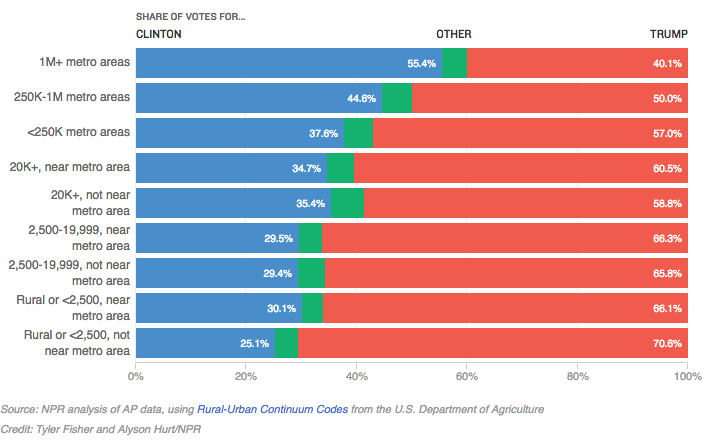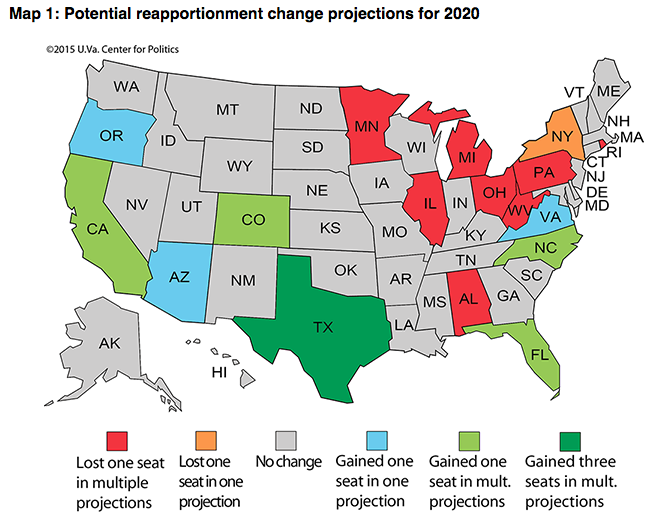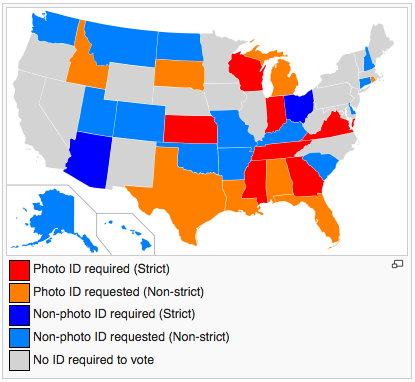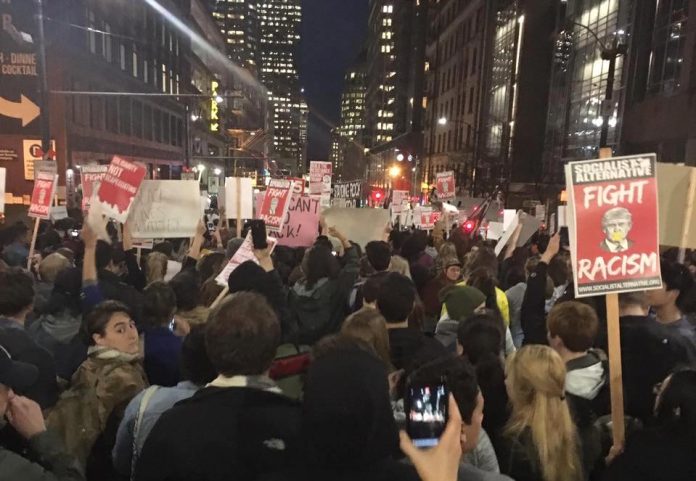In the wake of last Tuesday’s electoral collapse, think pieces have abounded. I’ve spun myself in circles and tied my stomach into knots trying to digest the indigestible. More than a few outlets have argued that cities hold the key to countering America’s first orange president and the fascist vision he’s outlined.
It’s fitting that promoting urbanism would excite an urbanist blogger, but I also think there’s a limit to what city-making alone can accomplish as a form of political resistance. Unfortunately the Electoral College limits the payoff of accumulating population in our liberal cosmopolitan centers, which already vote Democrat by a wide margin. Running up the margin even more in California, New York, Massachusetts, Illinois, District of Columbia, or Washington doesn’t get us to 270 electoral votes.
Moreover, if coastal city population growth comes from young educated people leaving Ohio, Pennsylvania, Michigan, and Wisconsin, it might make winning those formerly reliably blue states even harder. That’s why better-city making can’t just be about housing growth in booming cities like Seattle, but also revitalizing struggling cities and invigorating towns that feel left behind all across the nation, like Chuck Marohn with Strong Towns has made his mission.

Electoral Map Changes In 2022
Reapportioning the Electoral College’s balance of power won’t happen until 2022, after the results of the 2020 Census have been tabulated. Texas is projected to be the biggest winner, gaining three congressional seats bringing its electoral votes to 41. California, Colorado, North Carolina and Florida seem solid bets to gain one, while Oregon, Arizona and Virginia could also gain one. The states that likely will lose one congressional seat and thus one electoral vote are clustered in the Rust Belt plus Alabama and Rhode Island.

Washington state is expected to hold steady with its 12 electoral votes; however, an uptick in population growth could put us in the conversation for an extra congressional district and vote. That seems a worthy goal, especially since we are making the transit investments to support that growth in Seattle and Spokane. But succeeding in snagging another electoral vote would require picking up the pace to beat projections.
The shifting of electoral power to the South may eventually make it essential to flip some former Republican strongholds such as Arizona, North Carolina, Texas, and Georgia that do seem to have some favorable demographic trends for Democrats notwithstanding our recent setback. Those places are getting more racially diverse and they each have big cities that are pulling in young people for jobs and cultural opportunities.
The Popular Vote
A strategy that relies on flipping Texas has its drawbacks though since we have 10 points to make up. Instituting the popular vote would be the most elegant and profound answer to our conundrum of the Electoral College emphasizing rural votes and translating popular vote victories into electoral losses. Democrats won the popular vote by 2 million votes (projected) this year but still lost the Electoral College decisively 306 to 232 (projected). It may not be widely known, but since 2009 Washington has been signatory on a compact to pledge state electoral votes to the winner of popular votes along with 10 other states representing 165 electoral votes in total. Once that compact gets to 270 votes, it would essentially circumvent the Electoral College so that our presidential elections reflect the will of the people.
So far, the signatories are only the usual liberal suspects: California, New York, Illinois, New Jersey, Washington, Massachusetts, Maryland, Hawaii, Rhode Island, DC, and Vermont. The idea will have to catch on beyond very blue states to become law. Polls show public support hovering around 70% even in red states like Georgia, Kentucky and Arizona, but, having won only one popular vote in the last seven presidential elections, the Republican Party is likely to block the idea, and they gained a governing trifecta in four more states (Iowa, Kentucky, Missouri, and New Hampshire) bringing the total of states where they have complete control to 24. Additionally, the Republican Party controls both chambers of 33 state legislatures. Plus, our new despotic commander-in-chief would not want to countenance a reform that would make his re-election less likely.
Instituting the popular vote could also be done by constitutional amendment, either through the Supreme Court or via constitutional convention, although neither avenue seems open at the moment. Long-term, the popular vote is the best solution to end our presidential election madness and get fair representation for our silenced urban majority. However, we can’t count on instituting such a profound reform by the next presidential election in 2020.
Countering Voter Suppression
One area where we can maybe move more quickly is countering the voter suppression tactics that may have been instrumental to eroding Democratic support in the Rust Belt. This has been a deliberate effort on the Republicans’ part. One voter purging organization, Crosscheck, challenged more than a million Americans voting rights by claiming they were duplicates, the majority of whom were likely unfairly disenfranchised. Journalist Greg Palast obtained data from Crosscheck to break open the story sounding the alarm in an August Rolling Stone article:
If Virginia’s 13 percent is any indication, almost 1 million Americans will have their right to vote challenged. Our analysis suggests that winding up on the Crosscheck list is hardly proof that an individual is registered in more than one state. Based on the data, the program – whether by design or misapplication – could save the GOP from impending electoral annihilation. And not surprisingly, almost all Crosscheck states are Republican-controlled.
If Republicans couldn’t get people off the rolls with their purges, they invoked another strategy in requiring voter ID to turn them back at polling places. Some states allow provisional ballots but processing those is at the discretion of the local election officials. We should try to repeal the voter ID laws that disenfranchised hundreds of thousands and helped drive down turnout in 2016. Wisconsin enacted one of the most restrictive voter ID laws in the country and saw about 300,000 fewer votes–and 41,000 fewer in Milwaukee alone–than in 2012 before it was enacted. That translated to a drop of about 4% in turnout from 2012 and a twenty-year low in a state Hillary Clinton lost by just 27,257 votes.

Wisconsin was far from alone in enacting voter ID laws with about 32 states with laws on the books of varying strictness. Federal courts even struck down voter ID laws in North Carolina and Texas that it deemed went too far in the weeks ahead of the election. Voter ID laws are a solution in search of a problem since in-person voter fraud is virtually non-existent. Nonetheless, public polling shows they are relatively popular perhaps because the idea sounds good in the abstract, while its side effects of making it hard for poor folks to vote and driving down turnout aren’t as well known.
Another popular suppression tactic in full display since the Supreme Court gutted the Voting Rights Act in 2013 has been to curtail the number of polling places and reduce early voting. Lengthening lines at polling stations have become the Republican Party’s defense, especially in urban areas where Democrats most need to do well to win.
The results of these voter suppression efforts? Nationally, turnout was down more than 4% from its 2008 high-water mark:
The raw number of votes rose: About 1.4 million more Americans voted in this year’s election than in 2012, a total which itself was down from 2008. But the electorate was growing in the meantime: About 57 percent of eligible voters cast ballots this year, down from 58.6 percent in 2012 and 61.6 percent in 2008, which was the highest mark in 40 years.
Democrats would be wise to make repealing these unfair laws a priority. Automatic voter registration would help make voting easier and counter some of these suppression tactics. To succeed, they are likely going to need to retake more state legislatures so they can have a say in crafting voting laws. A big progressive wave in the 2018 midterm election would lay the groundwork for those changes. The focus going forward should be on encouraging voter turnout rather than adding hoops to jump though in the trumped up name of voter integrity.
What Exit Polls Tell Us
Strangely the punditry that so epicly misinterpreted pre-election polling data immediately turned to pouring over exit poll data to cook up some more hot takes. One such early take was that people of color didn’t turnout for Clinton in as large of numbers as they did for Obama. Exit polling is a rough snapshot and should be taken with a grain of salt. An organization called Latino Decisions did a more in-depth polling and analysis of Latino voting patterns and concluded turnout among Latinos jumped by about 3 million to roughly 14 million and broke overwhelmingly for Clinton, surpassing Obama’s percentages.
Nationally, Clinton received a record-high 79 percent to 18 percent for Trump, with 3 percent voting for one of the third-party candidates. This 61 percent gap is the largest we have recorded at Latino Decisions, outpacing the 2012 Obama advantage over Romney, at 75 to 23 percent.
Exit polls estimate Black voters broke for Clinton by 80 points, which is a huge advantage but less than Obama’s colossal 87 point advantage in 2012 and his nearly unanimous 91 point margin in 2008. Meanwhile, the margin of victory among Asian-Americans seems to have shrunk from 47 points in 2012 to 36 points in 2016. It’s surprising that slightly less support among Asian-Americans and Blacks is being used to argue people of color cost Clinton the election. Whites overwhelmingly made up our orange septuagenarian authoritarian’s base of support and accounted for his electoral victory.
Exit polls estimate Clinton won women by 12 points nationally, which is about the same margin of victory as Obama garnered in 2008 and 2012, and saw only a one percent rise in turnout among women. That margin was much smaller in Florida, which exit polls showed had only a four point advantage for Clinton among women. What’s more, Edison Research estimates Clinton did not win white women nationally, gaining only 43% to the 53% who voted orange. Apparently white women without a college degree broke even sharper with a 34-62 split.
Another troubling thing exit polls indicate is that Clinton won Wisconsin, Pennsylvania, Florida and North Carolina, more than enough to flip the election result if it were true. Some have suggested this may indicate a rigged election or even that Russian hackers tampered with vote tabulation in certain states. But conspiracy theories aside, exit poll discrepancies, if accurate, could indicate many people had their votes invalidated or denied by one of the methods mentioned above, skewing the results. We need to take voting rights seriously.
A Rebuke Of Democratic Strategy
Losing this election had much to do with sexism, racism, xenophobia, and an election system stacked against the progressive coalition. But the loss was also a reflection of bad strategy by the Democratic Party suggesting a party that’s unmoored and adrift on some key issues. I’m not going to repeat all the Wednesday morning strategist points, but a stronger platform on economic justice and financial reform and accountability would have likely energized voters better than the less substantive “I’m With Her.”
Yelling “racist” and “misogynist” in the face of red voters can be cathartic but may ultimately be less than effective when it comes to earning their votes next time around. We have to stand up to worst of America’s new ruling party: racism, sexism, transphobia, homophobia, and anti-immigrant fervor. We cannot normalize it. But we also have to convince people–if not the Republican voters then at least the independents and the 43% of eligible voters who didn’t vote–otherwise we are just screaming into the abyss. Hopefully fighting racism and sexism head-on converts some under its hold and brings them onboard to a progressive agenda.
To win over voters who may not be racist themselves but decided racism wasn’t a deal-breaker–or a good enough reason to get to the polls to vote against it–the party should also appeal to poor and middle class voters with better policies, messaging, and mobilization strategies. Clinton did win voters making less than $50,000 per year by 11 points according to exit polls, but a Democrat should win this demographic even more decisively, especially when Republicans are proposing massive tax cuts for the rich and gutting Medicare and Medicaid.
Meanwhile, voters making between $50,000 and $100,000 broke for Trump by 4 points. This is a demographic that may well find itself in Obamacare affordability gap. A better health care policy may drive out better turnout in this demographic and it’s unlikely to come from the ridiculously thin ideas Republicans have offered. Perhaps it’s time to renew the push for single-payer healthcare and stop the madness of running an industry that dictates human survival with a strong profit motive.
Naomi Klein wrote a piece titled “It was the Democrats’ embrace of neoliberalism that won it for Trump” in The Guardian and has suggested a green New Deal to jump-start both the economy and our resistance to climate change:
Neo-fascist responses to rampant insecurity and inequality are not going to go away. But what we know from the 1930s is that what it takes to do battle with fascism is a real left. A good chunk of Trump’s support could be peeled away if there were a genuine redistributive agenda on the table. An agenda to take on the billionaire class with more than rhetoric, and use the money for a green new deal. Such a plan could create a tidal wave of well-paying unionised jobs, bring badly needed resources and opportunities to communities of colour, and insist that polluters should pay for workers to be retrained and fully included in this future.
We need to craft a party platform and vision that energizes more people across political divides and doesn’t rely on identity politics alone. Can the Democratic Party be trusted to regulate Wall Street, Big Oil, and Big Pharma and tame their excesses? Can the party build its base in all fifty states and reverse the trend of Republican takeovers of state legislatures?
A good way to start is with a fresh progressive to lead the Democratic National Committee (DNC). The progressive wing is rallying around Minnesota Congressman Keith Ellison who famously was laughed at when he tried to tell ABC Chief Anchor George Stephanopoulos (a former senior staffer under the Bill Clinton administration) that Trump was a real threat to take the Whitehouse back in July. Senator Elizabeth Warren has backed Ellison and Senator Bernie Sanders is circulating a petition in support of his candidacy.
For urbanists, we can help in the interim by making our places more inclusive and by welcoming more people into our midst with friendly housing policies. Population growth in cities is a sound strategy long term to gain more electoral clout for states like Washington. However, we cannot lose sight of the best path to win elections in the short term and that involves expanding and mobilizing our base and pushing back against shameless voter suppression tactics. The fight begins now.
Title image by Ben Crowther at “Fight Racism” protest in downtown Seattle on November 9th.
Doug Trumm is publisher of The Urbanist. An Urbanist writer since 2015, he dreams of pedestrian streets, bus lanes, and a mass-timber building spree to end our housing crisis. He graduated from the Evans School of Public Policy and Governance at the University of Washington in 2019. He lives in Seattle's Fremont neighborhood and loves to explore the city by foot and by bike.


